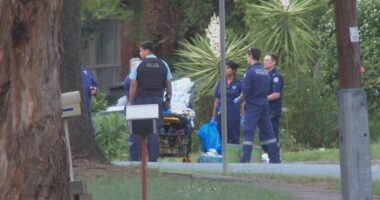Share this @internewscast.com
“If you’re not financially well-off, purchasing property in areas like this might not be advisable because insurance premiums are prohibitively high, making it difficult to secure financing,” Anthi Emmanuoil-Playne explained to Insight.
It wasn’t long after they moved in that tragedy occurred. In February 2024, severe fires ravaged the Grampians as well as nearby towns, including Halls Gap and Pomonal. The inferno consumed their 1.6-hectare property, completely destroying their residence.

Bushfires in 2024 devastated Anthi Emmanuoil-Playne home, which is prohibitively expensive for her to rebuild. Source: Supplied
Emmanuoil-Playne had insurance and was given around a $600,000 payout, but says it wasn’t enough to rebuild in a way that meets Bushfire Attack Level (BAL) ratings, which means her home is resistant against future fires — and less risky for insurers.
To add to the sting, building material costs have tripled.
“We’re really stuck.”
With insurance, ‘onus is on you’
“I remember saying to the kids when it happened: ‘We have to expect that we could be dealing with this for 12 months’,” she told Insight.

Elizabeth Mackney has lived in a floor-damaged home for around three years. Source: Supplied
Mackney spent the next three years battling her insurer after they disagreed over the price of repairs. She ended up taking them to the Australian Financial Complaints Authority, which ruled in her favour.
“Our house is still not repaired because we’ve only just received the payout.”
Insurance ‘telling us’ these places are unsafe
“The floods in 2022 resulted in the largest insurance losses we’ve encountered. This past year marks the first occasion where companies have seen a return to profitability. This is largely due to the absence of natural disaster events during the first half of this financial year.”

More and more properties across Australia are becoming too expensive to insure. Source: SBS
In 2024, Australia’s insurance industry recorded an after-tax profit of $6.1 billion — three times higher than the previous five-year average, according to KPMG.
“We need access to more capital to underwrite the risks we have in this country,” he says.

Source: SBS
Climate Council analysis shows 652,424 properties (4.4 per cent or one in 23) across the country are already at high risk from one or more hazards — properties for which insurance is often already unaffordable or unavailable. This number is expected to grow to 746,185 (5 per cent) by 2050 and 1.3 million (8 per cent) by 2100.
“There are areas of Australia that now have so many properties that are effectively uninsurable, meaning too expensive. It’s not safe for people in certain areas to stay in those places, and the insurance is telling us that,” she said.
Rebuild costs higher than insurance
Hall from the insurance council agrees. “Plain English is critically important,” he says. “And it’s something the industry has been working on.”
“Think about if the worst happens in this current day, what would it actually cost to rebuild your property?”
Governments stepping in
When water rose to just below her ceiling, Hutch climbed out of her attic window and onto her roof, where she was rescued by SES volunteers.

Denise Hutch lost her uninsured home in the 2022 Lismore floods. Source: Supplied
Like Emmanuoil-Playne, she had bought in Lismore because it was affordable, though like many in the area, couldn’t afford the flood insurance, so took the risk and went without.
“If that’s not enough money, I don’t have a lot of choices after that.”
Reducing the risk
The most important way we can reduce risk, she says, is “mitigating against climate pollution in the first place”.

Source: SBS
Jarzabkowski says to keep people insured, we need to make houses more durable and move people away from high-risk areas.












